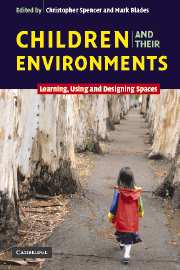Book contents
- Frontmatter
- Contents
- Notes on contributors
- An introduction
- Part I Children's understanding of places
- Part II Children's experience of places
- 5 Learning neighbourhood environments: the loss of experience in a modern world
- 6 The classroom environment and children's performance – is there a relationship?
- 7 ‘Sometimes birds sound like fish’: Perspectives on children's place experiences
- 8 Is contact with nature important for healthy child development? State of the evidence
- 9 Environmental child-friendliness in the light of the Bullerby Model
- Part III Adolescents' worlds?
- Part IV Children and the design process
- Index
- References
8 - Is contact with nature important for healthy child development? State of the evidence
Published online by Cambridge University Press: 23 October 2009
- Frontmatter
- Contents
- Notes on contributors
- An introduction
- Part I Children's understanding of places
- Part II Children's experience of places
- 5 Learning neighbourhood environments: the loss of experience in a modern world
- 6 The classroom environment and children's performance – is there a relationship?
- 7 ‘Sometimes birds sound like fish’: Perspectives on children's place experiences
- 8 Is contact with nature important for healthy child development? State of the evidence
- 9 Environmental child-friendliness in the light of the Bullerby Model
- Part III Adolescents' worlds?
- Part IV Children and the design process
- Index
- References
Summary
We know that children need nature … or do we? There are certainly many reasons to think that nature plays an important role in child development. For many of us, intuition emphatically asserts that nature is good for children. We hold intuitions such as, ‘every kid needs a dog’, ‘children need a nice yard to play in’, and ‘children need “fresh air”’. Beyond these intuitions, there are also well-reasoned theoretical arguments as to why humans in general – and therefore children – might have an inborn need for contact with nature (e.g., S. Kaplan, 1995; Wilson, 1984). And there is a growing body of qualitative research consistent with this idea (Bardill, 1997; Hart, 1979; R. Moore, 1989; R. C. Moore, 1986; Nabhan, 1994; Sebba, 1991; Sobel, 1993; Titman, 1994). But what do we really know about the value of nature in promoting child development? What systematic evidence is there for or against this possibility? Is children's need for nature established fact, yet-to-be-substantiated folk theory, or simply myth?
The question of nature's role in healthy child development is increasingly urgent. A consistent concern among the researchers studying children and nature is that children's access to nature is rapidly diminishing (e.g., Kahn, 2002; Kellert, 2002; Pyle, 2002; Rivkin, 2000). Not only may there be less nature for children to access, but children's access of what remains may be increasingly sporadic.
- Type
- Chapter
- Information
- Children and their EnvironmentsLearning, Using and Designing Spaces, pp. 124 - 140Publisher: Cambridge University PressPrint publication year: 2006
References
- 86
- Cited by



